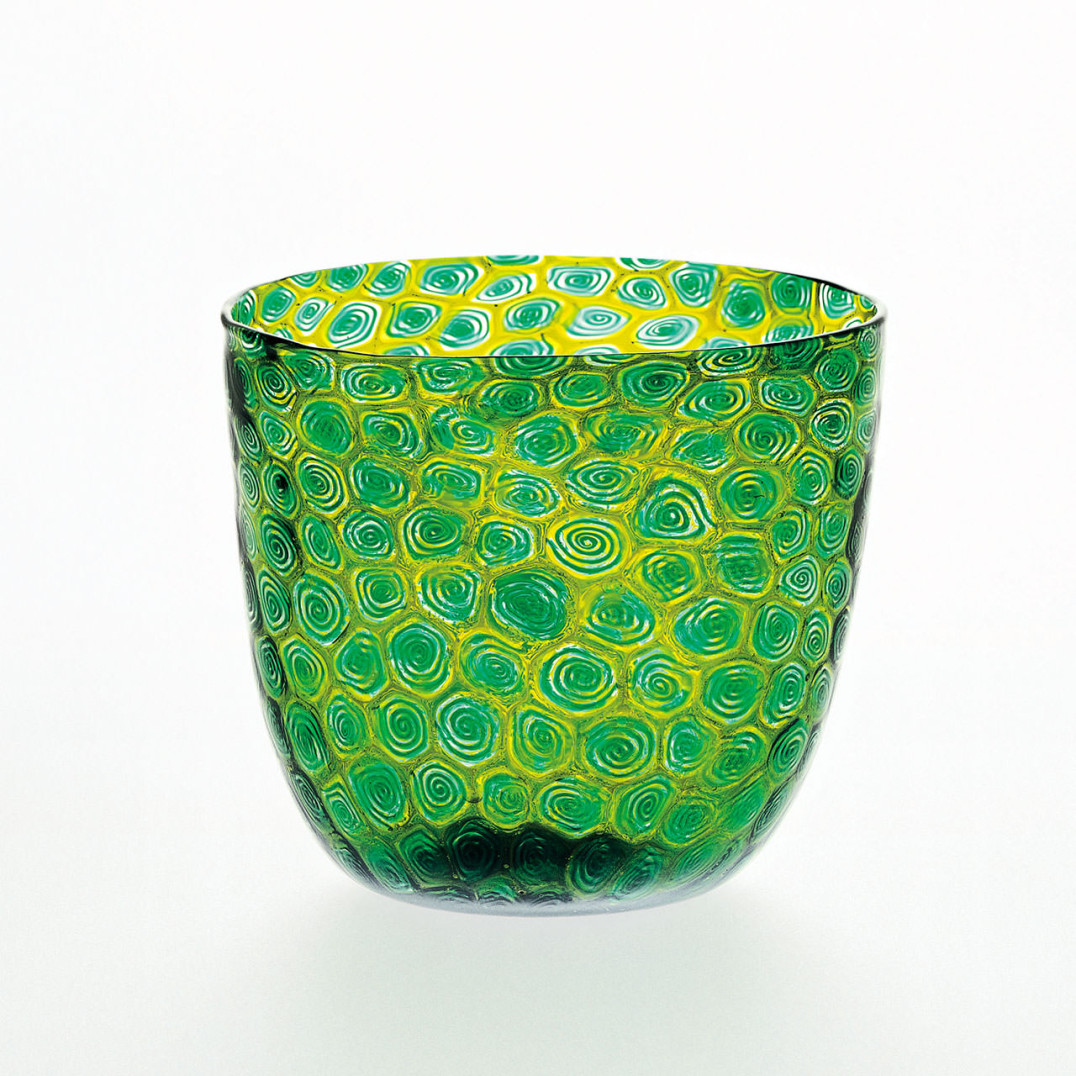
Ermanno TosoMurrine spiraliformi, 1960-1962
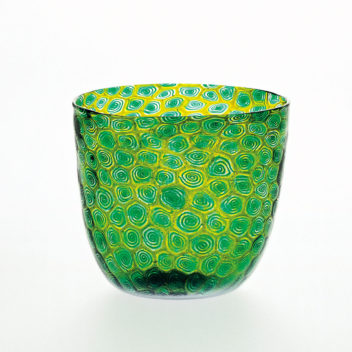
Ermanno TosoMurrine spiraliformiFratelli Toso, 1960-1962
Bowl composed of green, blue, and yellow spiraled murrine.
Original paper label: Murano Glass Made in Italy.
5 1/2 in. high (14 cm)
Exhibitions:
1962, Venice, 31st Biennale Internazionale d’Arte;
1963, Venice, Exhibition of Murano Glass, Opera Bevilacqua La Masa;
2000, New York, Venetian Glass, Museum of Arts & Design;
2001, Milan, Murano: Vetri dalla Collezione Olnick Spanu, Spazio Oberdan.
Bibliography and comparison texts:
Mostra del vetro…, 1963;
M. Heiremans, 1989, nn. 158, 159;
M. Barovier, R. Barovier Mentasti,
A. Dorigato, 1995, p. 141;
F. Deboni, 1996, n. 170;
M. Heiremans, 1996, n. 219;
M. Barovier, 1999, p. 258;
Olnick Spanu, 2000, n. 119;
Olnick Spanu, 2001, n. 158.
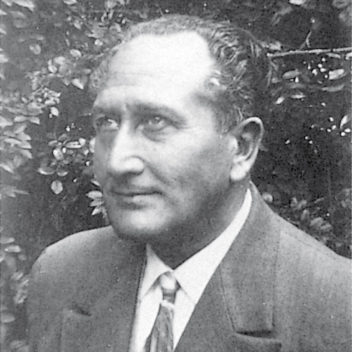
Ermanno Toso 1903–1973
Born on Murano, Ermanno Toso began to work at the Fratelli Toso workshop in 1924, where he was later to become a partner. In 1936, he was named artistic and marketing director of the company. During the period preceding World War II, he created thick glass pieces using traditional decorative techniques that were characterized by simple and solid shapes inspired by the Novecento style. During the '50s, he created a collection of extraordinarily lightweight glass pieces based on a modern interpretation of classical techniques, such as filigrana and murrina. During the '60s, his creative talent led him towards an absolute multicolored sobriety.
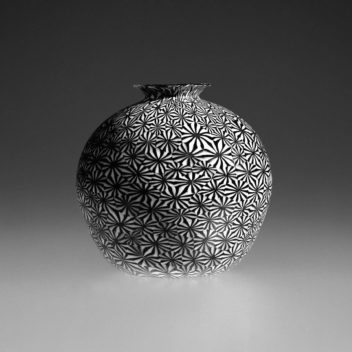
Fratelli Toso 1954–1982
Founded in 1854 by the brothers Ferdinando, Carlo, Liberato, Angelo, Giovanni, and Gregorio Toso, Fratelli Toso initially produced pharmaceutical bottles for domestic use. These were soon followed by reproductions of antique glass pieces. In the early 1900s, the company produced objects and chandeliers in the floral style executed with the murrine technique. In 1912 and 1914, Fratelli Toso obtained great success at the Biennale di Venezia by presenting works by the Norwegian artist Hans Stoltberg Lerche. In 1934, however, a remarkable change was noted in their work presented at the Biennale di Venezia. In 1936, the artistic direction of the company was assumed by Ermanno Toso, who progressively revisited the techniques of Murano glass, reinterpreting them in a personal style. These works received widespread acclaim, especially after World War II. During the '60s and '70s, the works of Renato, Giusto and Rosanna Toso, who often used transparent glass, brought a decidedly modern look to the company. The furnace was closed in 1982.
Ermanno TosoMurrine spiraliformi, 1960-1962
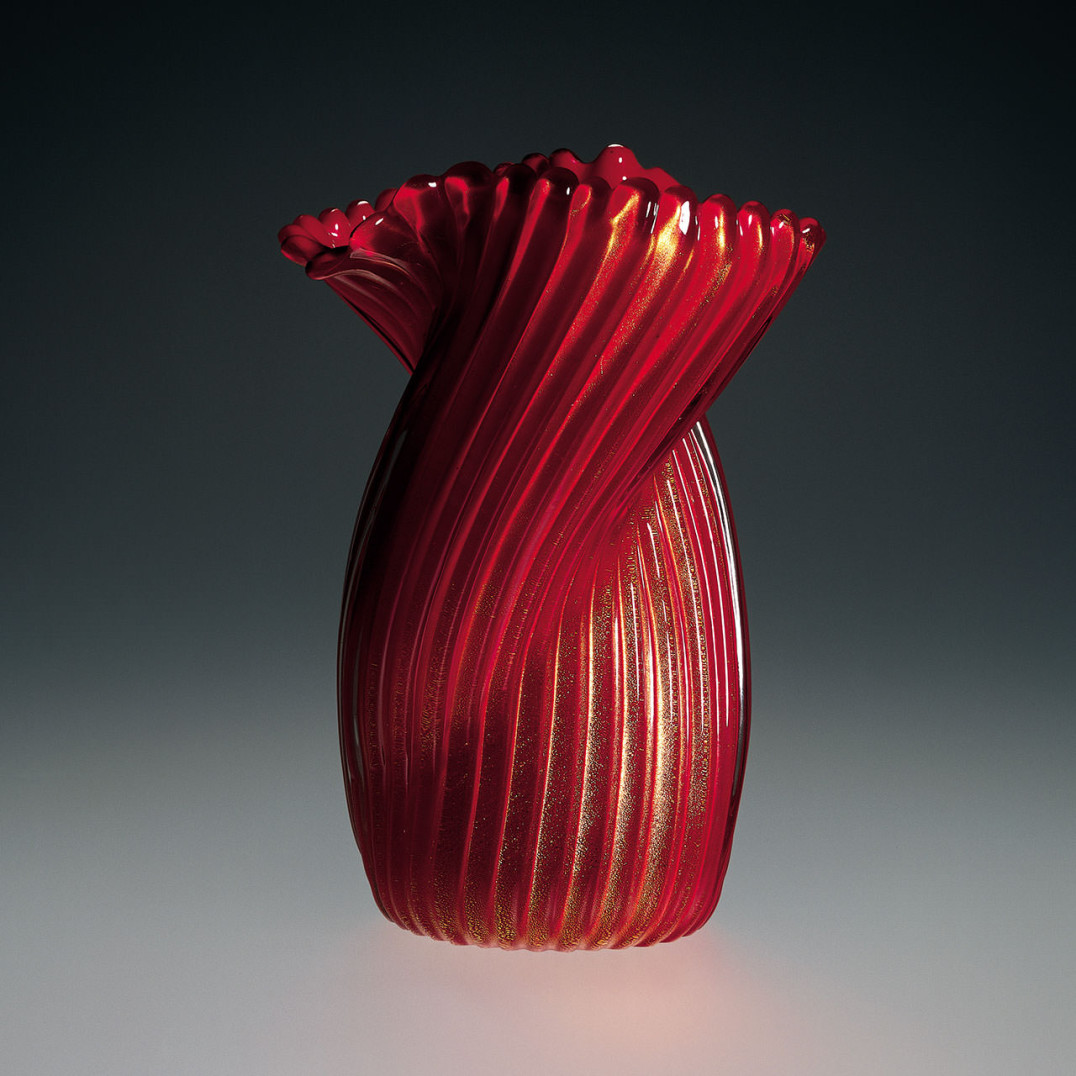
Archimede SegusoRitorto a coste, 1950
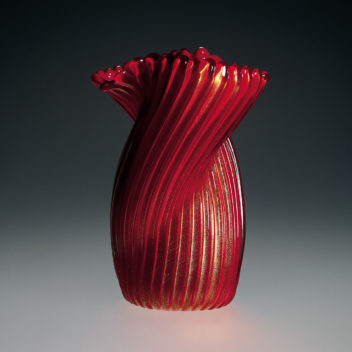
Archimede SegusoRitorto a costeVetreria Archimede Seguso, 1950
Vase in translucent red glass with twisted ribbing and inclusions of gold leaf.
11 3/8 in. high (28.9 cm)
Exhibitions:
2000, New York, Venetian Glass, Museum of Arts & Design;
2001, Milan, Murano: Vetri dalla Collezione Olnick Spanu, Spazio Oberdan.
Bibliography and comparative texts:
U. Franzoi, 1991, n. 35;
R. Barovier Mentasti, 1995, n. 3;
Olnick Spanu, 2000, n. 117;
Olnick Spanu, 2001, n. 157.
A vessel in transparent red glass with one large aperture, two side lips and a stylized handle; inclusions of gold leaf throughout.
11 1/2 in. high (29 cm)
Bibliography and comparative texts:
R. Linzeler, 1922, p. 666;
C. Carrà , 1923, p. 67;
R. Linzeler, 1923, p. 83;
R. Papini, 1930, n. 570;
G. Mariacher, 1967, p. 98;
R. Barovier Mentasti, 1982, n. 252;
Mille anni…, 1982, n. 503;
F. Deboni, 1984, p. n. 70;
W. Neuwirth, 1987, nn. 7, 104;
A. Dorigato, 1986,
p. 71;
F. Deboni, 1989, n. 1;
L’arte del vetro, 1982, n. 307;
M. Heiremans, 1993, n. 191;
M. Barovier, R. Barovier Mentasti,
A. Dorigato, 1995, n. 15;
A. Venini Diaz de Santillana, 1996, n. 1;
R. Barovier Mentasti, 1998, n. 25;
A. Venini Diaz de Santillana, 2000, n. 1;
Olnick Spanu, 2000, n. 8;
Olnick Spanu, 2001, n. 13.

Archimede Seguso 1909–1999
Born on Murano and the son of the maestro Antonio Seguso, Archimede Seguso began work at a very early age in the Vetreria Artistica Barovier, where his father was a partner. In 1933, he was one of the founding partners of the Artistica Vetreria e Soffieria Barovier Seguso & Ferro, which was later to become the Seguso Vetri d'Arte. Here, Archimede worked asmaestro of the principal team crafting the pieces designed by Flavio Poli, and later his own pieces inspired by the Novecento style. He sold his share of the workshop to his partners and, in 1946, founded a new workshop, the Vetreria Artistica Archimede Seguso, where he was first maestro and creator of almost all the works produced there. The first glass pieces were still inspired by the Novecento, as were his sculptures modeled in hot glass; at the same time he experimented with thin blown glass textured in many ways, adapting ancient decorative techniques to the styles of the '50s such as, for example, the variations of filigrana that he presented throughout the decade (Merletti, Composizione Lattimo, Piume, etc.). During the '60s and '70s, he created intensely colored glass works such as the colori sovrapposti and the fasce sovrapposte, and further pushed the filigrana technique with his Spinati, and a petali glass pieces. Later on, he based his production on strong contrasting colors. Among his last works is the series of sculptures called Rotture, conceived as original works and made in solid massiccio sommerso glass, a realization of the profound reflections of this artist who later died on the island of Murano.
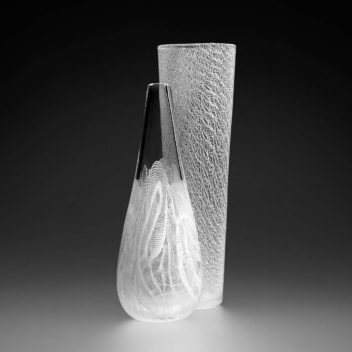
Vetreria Archimede Seguso 1946–
Vetreria Archimede Seguso was founded in 1946 by Archimede Seguso, partner and glassmaster at Seguso Vetri d'Arte until 1942. Seguso was not only the tireless creator of almost all the collections produced by Vetreria Archimede Seguso, he executed his own works and experimented with new techniques and materials. He participated in the Biennali di Venezia and the Triennali di Milano from 1950 on, presenting, among other things, his own personal interpretations of the ancient technique of filigrana. His interpretaions, vessels often enriched with applications of gold leaf, he called Merletti. The company is now run by his son Gino Seguso, with the assistance of his grandson Antonio Seguso.
Archimede SegusoRitorto a coste, 1950
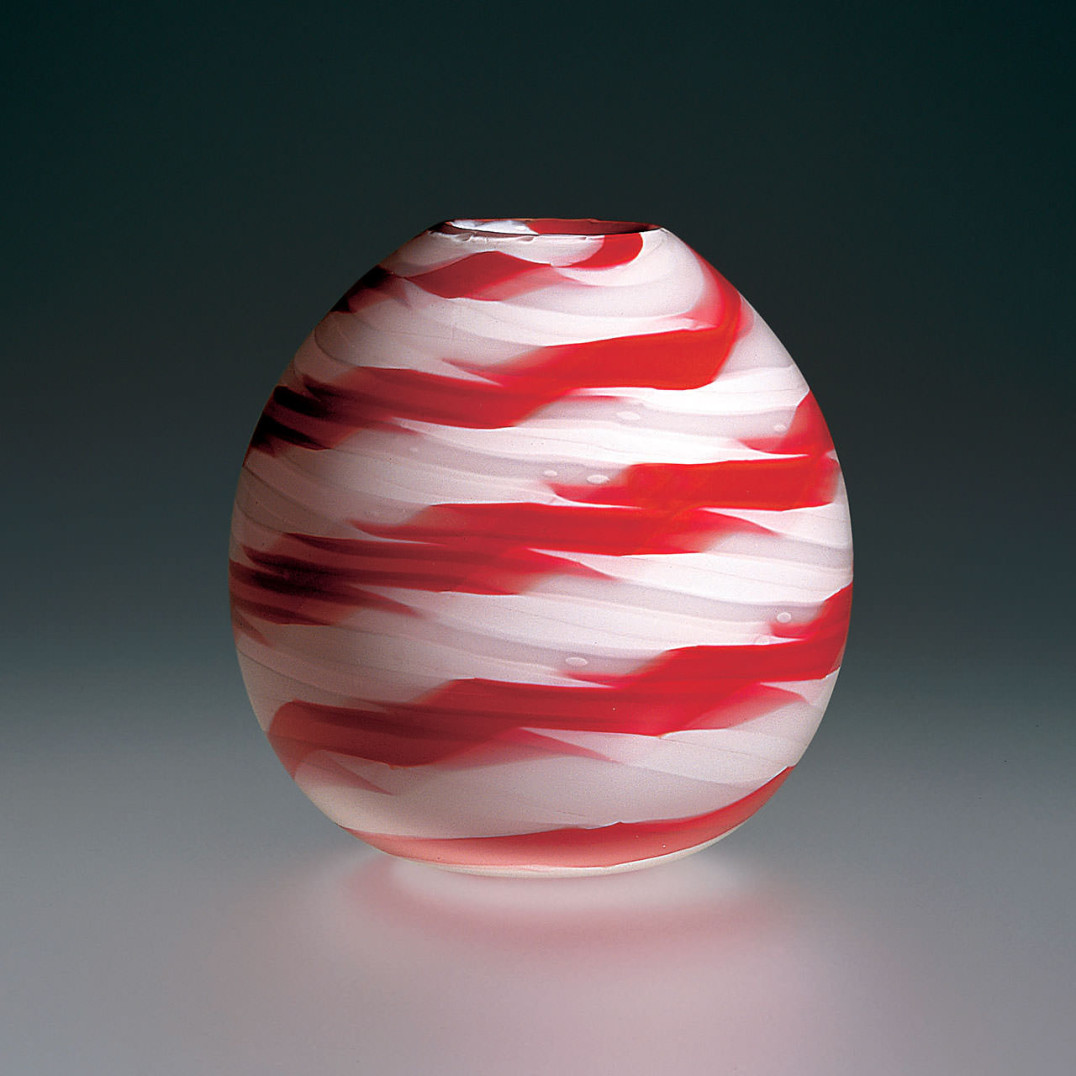
Archimede SegusoZig zag, 1951
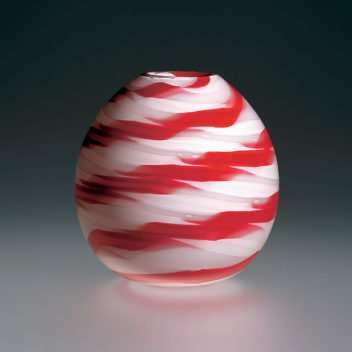
Archimede SegusoZig zagVetreria Archimede Seguso, 1951
Vase in clear transparent glass with inclusions of sections of lattimo and red glass canes laid out in a zig zag pattern. The surface is lightly decorated with the application of a gold leaf.
A similar work is part of
the collection of the Metropolitan Museum of Art in New York.
6 7/8 in. high (17.5 cm)
Exhibitions:
2001, Milan, Murano: Vetri dalla Collezione Olnick Spanu, Spazio Oberdan.
Bibliography and comparative texts:
U. Franzoi, 1991, n. 36;
Olnick Spanu, 2001, n. 156.

Archimede Seguso 1909–1999
Born on Murano and the son of the maestro Antonio Seguso, Archimede Seguso began work at a very early age in the Vetreria Artistica Barovier, where his father was a partner. In 1933, he was one of the founding partners of the Artistica Vetreria e Soffieria Barovier Seguso & Ferro, which was later to become the Seguso Vetri d'Arte. Here, Archimede worked asmaestro of the principal team crafting the pieces designed by Flavio Poli, and later his own pieces inspired by the Novecento style. He sold his share of the workshop to his partners and, in 1946, founded a new workshop, the Vetreria Artistica Archimede Seguso, where he was first maestro and creator of almost all the works produced there. The first glass pieces were still inspired by the Novecento, as were his sculptures modeled in hot glass; at the same time he experimented with thin blown glass textured in many ways, adapting ancient decorative techniques to the styles of the '50s such as, for example, the variations of filigrana that he presented throughout the decade (Merletti, Composizione Lattimo, Piume, etc.). During the '60s and '70s, he created intensely colored glass works such as the colori sovrapposti and the fasce sovrapposte, and further pushed the filigrana technique with his Spinati, and a petali glass pieces. Later on, he based his production on strong contrasting colors. Among his last works is the series of sculptures called Rotture, conceived as original works and made in solid massiccio sommerso glass, a realization of the profound reflections of this artist who later died on the island of Murano.

Vetreria Archimede Seguso 1946–
Vetreria Archimede Seguso was founded in 1946 by Archimede Seguso, partner and glassmaster at Seguso Vetri d'Arte until 1942. Seguso was not only the tireless creator of almost all the collections produced by Vetreria Archimede Seguso, he executed his own works and experimented with new techniques and materials. He participated in the Biennali di Venezia and the Triennali di Milano from 1950 on, presenting, among other things, his own personal interpretations of the ancient technique of filigrana. His interpretaions, vessels often enriched with applications of gold leaf, he called Merletti. The company is now run by his son Gino Seguso, with the assistance of his grandson Antonio Seguso.
Archimede SegusoZig zag, 1951
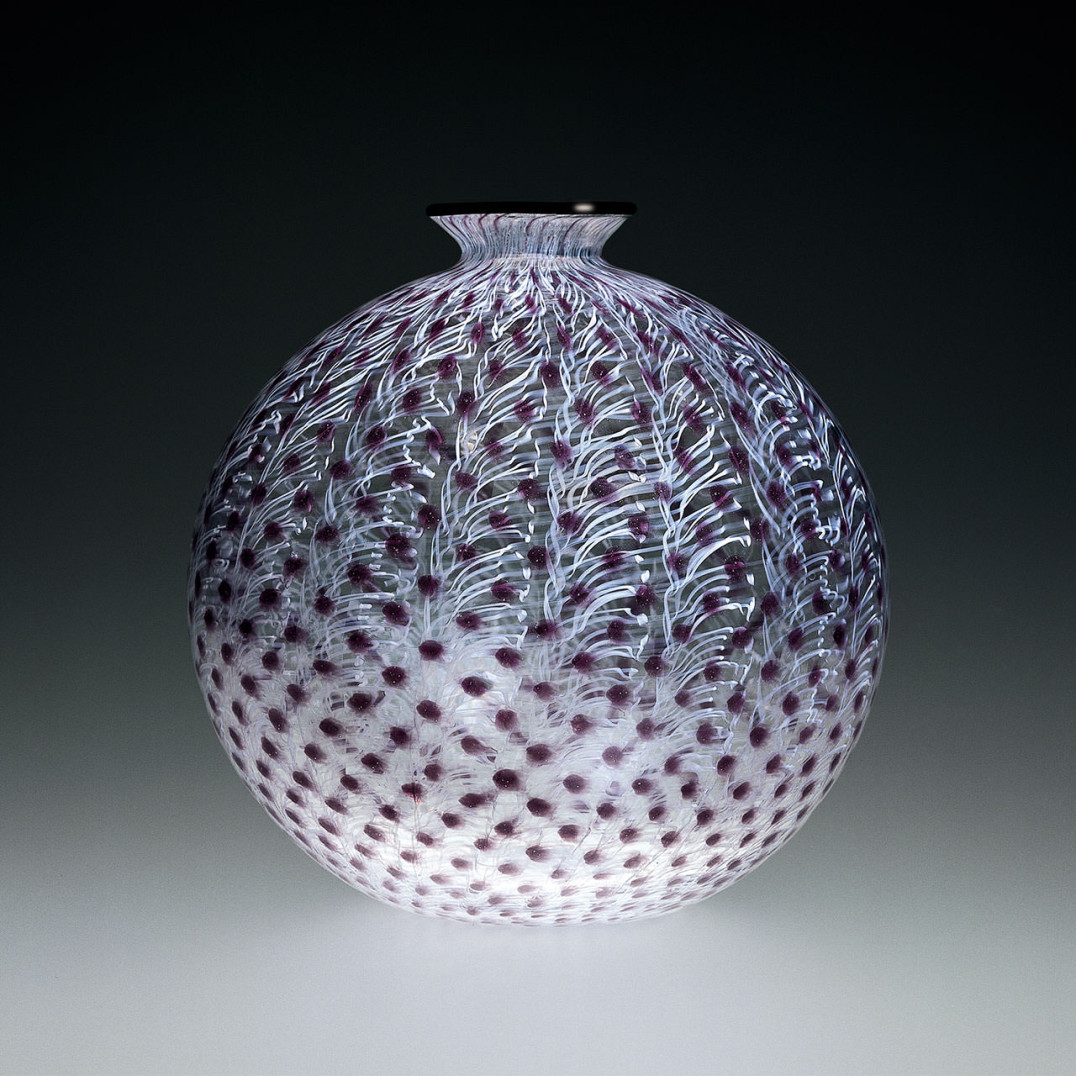
Archimede SegusoMerletto puntiforme, 1954
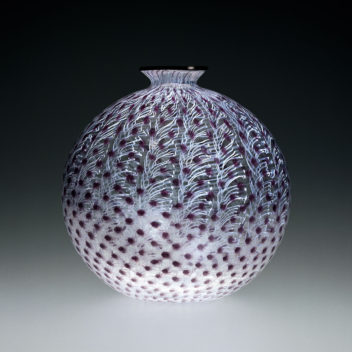
Archimede SegusoMerletto puntiformeVetreria Archimede Seguso, 1954
Globular vase made of transparent glass and decorated with threads of merletto lattimo with the addition of controlled puntini, spots of amethyst glass. Applied amethyst lip wrap.
9 7/16 in. high (24 cm)
Exhibitions:
2000, New York, Venetian Glass, Museum of Arts & Design;
2001, Milan, Murano: Vetri dalla Collezione Olnick Spanu, Spazio Oberdan.
Bibliography and comparative texts:
U. Franzoi, 1991, nn. 22, 86;
R. Barovier Mentasti, 1995, n. 39;
F. Deboni, 1996, n. 130;
H. Ricke, E. Schmitt, 1996, n. 180;
I merletti…, 1999, p. 11;
Olnick Spanu, 2000, n. 115;
Olnick Spanu, 2001, n. 155.

Archimede Seguso 1909–1999
Born on Murano and the son of the maestro Antonio Seguso, Archimede Seguso began work at a very early age in the Vetreria Artistica Barovier, where his father was a partner. In 1933, he was one of the founding partners of the Artistica Vetreria e Soffieria Barovier Seguso & Ferro, which was later to become the Seguso Vetri d'Arte. Here, Archimede worked asmaestro of the principal team crafting the pieces designed by Flavio Poli, and later his own pieces inspired by the Novecento style. He sold his share of the workshop to his partners and, in 1946, founded a new workshop, the Vetreria Artistica Archimede Seguso, where he was first maestro and creator of almost all the works produced there. The first glass pieces were still inspired by the Novecento, as were his sculptures modeled in hot glass; at the same time he experimented with thin blown glass textured in many ways, adapting ancient decorative techniques to the styles of the '50s such as, for example, the variations of filigrana that he presented throughout the decade (Merletti, Composizione Lattimo, Piume, etc.). During the '60s and '70s, he created intensely colored glass works such as the colori sovrapposti and the fasce sovrapposte, and further pushed the filigrana technique with his Spinati, and a petali glass pieces. Later on, he based his production on strong contrasting colors. Among his last works is the series of sculptures called Rotture, conceived as original works and made in solid massiccio sommerso glass, a realization of the profound reflections of this artist who later died on the island of Murano.

Vetreria Archimede Seguso 1946–
Vetreria Archimede Seguso was founded in 1946 by Archimede Seguso, partner and glassmaster at Seguso Vetri d'Arte until 1942. Seguso was not only the tireless creator of almost all the collections produced by Vetreria Archimede Seguso, he executed his own works and experimented with new techniques and materials. He participated in the Biennali di Venezia and the Triennali di Milano from 1950 on, presenting, among other things, his own personal interpretations of the ancient technique of filigrana. His interpretaions, vessels often enriched with applications of gold leaf, he called Merletti. The company is now run by his son Gino Seguso, with the assistance of his grandson Antonio Seguso.
Archimede SegusoMerletto puntiforme, 1954
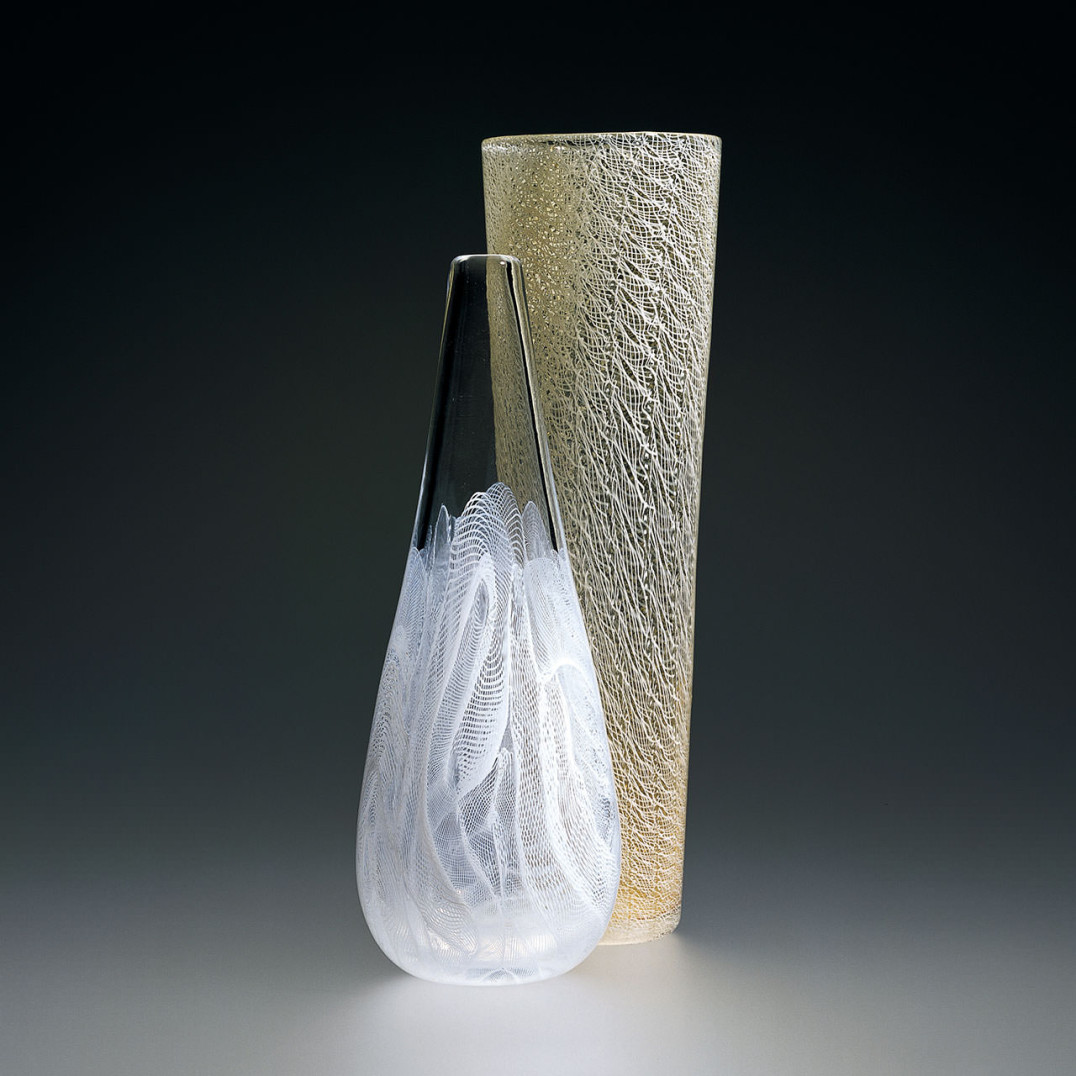
Archimede SegusoComposizione Lattimo, 1954
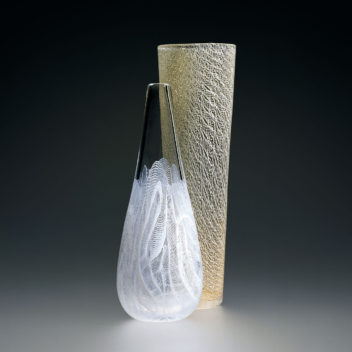
Archimede SegusoComposizione LattimoVetreria Archimede Seguso, 1954
Vase in cristallo glass with the
lower part crafted with canes of mezza filigrana.
13 in. high (33 cm)
Exhibitions:
1954, Venice, 27th Biennale Internazionale d’Arte;
2000, New York, Venetian Glass, Museum of Arts & Design;
2001, Milan, Murano: Vetri dalla Collezione Olnick Spanu, Spazio Oberdan.
Bibliography and comparative texts:
G. Mariacher, 1967, p. 135;
R. Barovier Mentasti, 1982, n. 311;
Mille anni…, 1982, n. 625;
M. Heiremans, 1989, n. 109;
U. Franzoi, 1991, nn. 26, 87-90;
M. Heiremans, 1993, nn. 122, 123;
M. Barovier, R. Barovier Mentasti,
A. Dorigato, 1995, n. 119;
Venezia e la Biennale…, 1995, n. 484;
F. Deboni, 1996, n. 129;
M. Heiremans, 1996, n. 147;
H. Ricke, E. Schmitt, 1996, nn. 185, 186;
Olnick Spanu, 2000, n. 113;
Olnick Spanu, 2001, n. 153.

Archimede Seguso 1909–1999
Born on Murano and the son of the maestro Antonio Seguso, Archimede Seguso began work at a very early age in the Vetreria Artistica Barovier, where his father was a partner. In 1933, he was one of the founding partners of the Artistica Vetreria e Soffieria Barovier Seguso & Ferro, which was later to become the Seguso Vetri d'Arte. Here, Archimede worked asmaestro of the principal team crafting the pieces designed by Flavio Poli, and later his own pieces inspired by the Novecento style. He sold his share of the workshop to his partners and, in 1946, founded a new workshop, the Vetreria Artistica Archimede Seguso, where he was first maestro and creator of almost all the works produced there. The first glass pieces were still inspired by the Novecento, as were his sculptures modeled in hot glass; at the same time he experimented with thin blown glass textured in many ways, adapting ancient decorative techniques to the styles of the '50s such as, for example, the variations of filigrana that he presented throughout the decade (Merletti, Composizione Lattimo, Piume, etc.). During the '60s and '70s, he created intensely colored glass works such as the colori sovrapposti and the fasce sovrapposte, and further pushed the filigrana technique with his Spinati, and a petali glass pieces. Later on, he based his production on strong contrasting colors. Among his last works is the series of sculptures called Rotture, conceived as original works and made in solid massiccio sommerso glass, a realization of the profound reflections of this artist who later died on the island of Murano.

Vetreria Archimede Seguso 1946–
Vetreria Archimede Seguso was founded in 1946 by Archimede Seguso, partner and glassmaster at Seguso Vetri d'Arte until 1942. Seguso was not only the tireless creator of almost all the collections produced by Vetreria Archimede Seguso, he executed his own works and experimented with new techniques and materials. He participated in the Biennali di Venezia and the Triennali di Milano from 1950 on, presenting, among other things, his own personal interpretations of the ancient technique of filigrana. His interpretaions, vessels often enriched with applications of gold leaf, he called Merletti. The company is now run by his son Gino Seguso, with the assistance of his grandson Antonio Seguso.